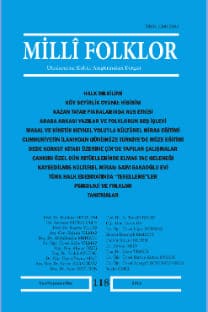ONUNCU YILINDA SOMUT OLMAYAN KÜLTÜREL MİRAS LİSTELERİ: GÖRÜNÜRLÜK, DEĞERLİLİK VE GÜVENİRLİK
Kısa adı UNESCO olan Birleşmiş Milletler Eğitim, Bilim ve Kültür Kurumunun 2003 yılında gerçekleşen Genel Konferansında kabul edilen Somut Olmayan Kültürel Mirasın (SOKÜM) Korunması Sözleşmesi'nin taraf devlet sayısı 2017 yılında 175'e ulaşmış ve sözleşmenin uluslararası toplumdaki görünürlüğü artmıştır. UNESCO'nun kültürel mirasla ilgili diğer beş sözleşmesi ile karşılaştırıldığında 1972 Sözleşmesi'nden sonra bu sözleşmenin kısa sürede uluslararası toplumun ilgisini çektiğini taraf devlet sayısında kısa sürede görülen artıştan hareketle söyleyebiliriz. Sözleşmenin uluslararası alandaki en önemli görünürlüğünü ise uluslararası listeler oluşturmaktadır. Bu listeler arasında Temsilî Liste sözleşmeye yönelik görünürlük, Acil Koruma Listesi korumaya yönelik değerlilik ve Korumanın İyi Uygulamaları Kaydı ise topluluk katılımına yönelik güvenirlik bakımından öne çıkmaktadır. Bununla birlikte sözleşmenin uluslararası görünürlüğü, değerliliği ve güvenilirliği üzerine yapılan bütün değerlendirmelerin merkezinde Temsilî Listenin yer aldığını söylemeliyiz. Öte yandan listelere kaydedilecek unsurlara ait dosyaları inceleyen ve Hükûmetler Arası Komiteye tavsiyede bulunan Değerlendirme Organında yer alan STK'lar açısından konuya bakıldığında ise, sözleşmenin özellikle kalkınmakta olan ülkelerde tabana yayılma ve toplulukların katılımı bakımından yeterli görünürlüğe ulaşmadığını itiraf etmeliyiz. Sözleşmeye taraf olan devletler açısından gruplara dağılım oldukça dengeli iken Akredite STK'ların seçim gruplarına dağılımında aynı denge ile karşılaşılmamaktadır. Bu da Hükûmetler Arası Komite açısından Değerlendirme Organına seçilecek uzman STK bulma zorluğunu ortaya çıkarmaktadır. Uzman STK havuzunun her seçim bölgesi için yeterli olmaması durumunda Değerlendirme Organına uzman olmayan STK'ların girmesi, böylece de alınan tavsiye kararlarının tartışılır hâle gelmesi riskini doğurmaktadır. Bunun yanında Hükûmetler Arası Komitede görev alan devletlerin yeterli uzmanlığa sahip olmamaları ve dosya sunan devletlerin unsurlarını bir an evvel listelere kaydettirme arzuları gibi olumsuzluklar da listelerin değerliliği ve karar süreçlerinin güvenirliğini olumsuz yönde etkileyebilmektedir
Intangible Cultural Heritage Lists in Tenth Year: Visibility, Valuableness and Reliability
The number of the State Parties to the Convention for the Safeguarding of the Intangible Cultural Heritage adopted at the General Conference of United Nations Educational, Scientific and Cultural Organization, UNESCO, held in 2003 has reached 175 in 2017 and the visibility of the Convention has increased among international society. Comparing to the five former cultural heritage Conventions of UNESCO, it can be suggested that the Convention for the Safeguarding of the Intangible Cultural Heritage was attracted considerable attention of the international community in a short time based on the indicator of increasing number of State Parties soon after the 1972 Convention. The prominent part of the visibility of the Convention in the international community is producing International Lists. The distinguished International Lists i.e. The Representative List, The Urgent Safeguarding List and Good Safeguarding Practices become prominent among others in that the visibility of the Convention, the valuableness of the safeguarding and the reliability towards community participation, respectively. At this point, we should mention that the Representative List locates at the centre of all assessments on the visibility, the valuableness and the reliability of the Convention. On the other hand, from the perspective of the NGOs who are the members of the Evaluation Body, responsible for the evaluation of the nomination files and for advising to the Intergovernmental Committee, we should mention here that the social inclusion of the Convention and the community participation are not visible enough especially in developing countries. While the distribution of the State Parties of the Convention to the groups is scattered rather homogeneously, the same adjusted distribution of the selection group of accredited NGO’s cannot be seen. This causes the Intergovernmental Committee to encounter the difficulty of finding the expert NGOs for the nomination to the Evaluation Body. For each selection region, the possibility of an insufficient number of expert NGOs poses a risk of non-expert NGOs inclusion to the Evaluation Body which results in the introduced recommendations to become highly controversial. Moreover, the inconveniences like inadequate proficiency of the State Parties that take charge in the Intergovernmental Committee as well as the rush due to the willingness of (file submitted states towards registering their elements negatively effects the intellectual values of the lists and the reliability of decision making processes
___
- Çalış, Sunay, UNESCO ve İnsanlığın Sözlü ve Somut Olmayan Mirası Başyapıtları ve Kültür Politikalarına Etkisi, Gazi Üniversitesi Sosyal Bilimler Enstitüsü Yüksek Lisans Tezi, Ankara, 2010.
- Deacon, Harriet, Dondolo, Luyuvo, Mrubata, Mbulelo ve Sandra Prosalendis. The Subtle Power of Intangible Heritage Legal and Financial Instruments for Safeguarding Intangible Heritage. HSRC Publishers, 2004.
- Hafstein, Valdimar Tr. “Intangible Heritage as a List From Masterpieces to Representation.” Intangible Heritage (ed. Laurajane Smith ve Natsuko Akagawa). Routledge. 2009: 93- 112.
- https://ich.unesco.org/fr, Erişim Tarihi: 10 Ekim 2017.
- https://ich.unesco.org/fr/11com, Erişim Tarihi: 10 Ekim 2017.
- https://ich.unesco.org/fr/12com-wg, Erişim Tarihi: 10 Ekim 2017.
- http://whc.unesco.org/archive/2017/whc17- 41com-18-fr.pdf, Erişim Tarihi: 10 Ekim 2017.
- Kirshenblatt-Gimblett, Barbara. “Intangible Heritage as Metacultural Production.” Museum International. 56. 2004. 1-15.
- Lixinski, Lucas. (2011). “Selecting Heritage: The Interplay of Art, Politics and Identity.” European Journal of International Law. 22. 2011: 81-100.
- Oğuz, M. Öcal, Somut Olmayan Kültürel Miras Nedir?, Ankara: Geleneksel Yayıncılık, 2013.
- Textes fondamentaux de la Convention de 2003 pour la sauvegarde du patrimoine culturel immatériel, UNESCO Yayını, 2016. (Elektronik nüsha için bakınız: https://ich.unesco. org/fr/textes-fondamentaux-00503)
- ISSN: 1300-3984
- Yayın Aralığı: Yılda 4 Sayı
- Başlangıç: 1989
- Yayıncı: Geleneksel Yayıncılık Eğitim San. Tic. Ltd. Şti.
Sayıdaki Diğer Makaleler
ONUNCU YILINDA SOMUT OLMAYAN KÜLTÜREL MİRAS LİSTELERİ: GÖRÜNÜRLÜK, DEĞERLİLİK VE GÜVENİRLİK
KARAMANLI NEOKESARİA KÖYÜNDE DOĞUM GEÇİŞİNE AİT İNANÇLAR
HEKİM FOLKLORUNDA STEREOTİPLERİN LAKAPLARI ŞEKİLLENDİRMESİ VE FIKRALARA YANSIMALARI1
KIRK KIZ EFSANESİNİN YAZILI KÜLTÜRDEKİ İKİ ÖRNEĞİ ÜZERİNE BİR DEĞERLENDİRME
AHMED YESEVİ’NİN YAŞNAMESİNDE “BİLGE KİŞİ” ARKETİPİ
BİYOGRAFİ: ETNOGRAFLAR İÇİN YÖNTEM VE ÖNERİLER
ALMIS KAĞAN DESTANI’NIN ARKETİPSEL TAHLİLİ
KAMUSAL ALAN VE MODERNLEŞME SÜRECİNDE KIBRIS TÜRK KADIN DERNEĞİ: VARLIK KULÜBÜ
